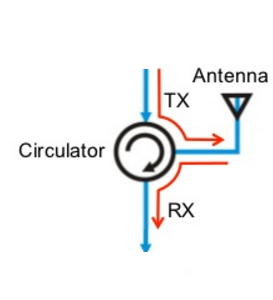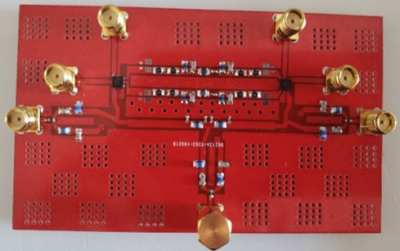0761
A Non-Magnetic Staggered Commutation Based Circulator to Achieve Time-Efficient Simultaneous Transmit and Receive (STAR) MRI
Hazal Yuksel1, Lance DelaBarre2, Djaudat Idiyatullin3, Julie Kabil4, Gregor Adriany3, Sung-Min Sohn5, Harish Krishnaswamy 1, John Thomas Vaughan 4, and Michael Garwood3
1Electrical Engineering, Columbia University, New York, NY, United States, 2Center for Magnetic Resonance Research, University of Minnesota, Minneapolis, MN, United States, 3University of Minnesota, Minneapolis, MN, United States, 4Columbia University, New York, NY, United States, 5Arizona State University, Tempe, AZ, United States
1Electrical Engineering, Columbia University, New York, NY, United States, 2Center for Magnetic Resonance Research, University of Minnesota, Minneapolis, MN, United States, 3University of Minnesota, Minneapolis, MN, United States, 4Columbia University, New York, NY, United States, 5Arizona State University, Tempe, AZ, United States
Synopsis
Traditional MRI relies on the temporal separation of the receiver (RX) and transmitter (TX) to solve the problem of self-interference. Often, the TX signal is billions of times larger than the RX signal, and T/R switches are used so the TX does not saturate or destroy the RX. This leads to an inefficient method of acquiring imaging data for especially fast decaying signals. We propose a magnetic-free, PCB based circulator to remove the T/R switch and achieve simultaneous transmit and receive MRI. We present images of a phantom acquired with a continuous SWIFT sequence to validate the concept.
Introduction
Traditional MRI relies on the temporal separation of the receiver (RX) and transmitter (TX) to solve the problem of self-interference - the TX pulse to excite the protons is around 80dB higher than what the RX encounters. Transmit-receiver (T/R) switches are used to time duplex the TX and RX pulses to protect the receiver, leading to time-inefficient imaging modalities especially for fast decaying signals (1). This problem has an analogue in the wireless communication domain, where all of today’s communications are either time-division duplex (TDD) or frequency-division duplex (FDD), where the transmission and reception are separated in time and frequency, respectively, leading to inefficient utilization of the spectrum. Emerging full-duplex or simultaneous-transmit-and-receive (STAR) communications (2) attempt to transmit and receive at the same time, improving wireless capacity.A similar approach may be pursued for MRI as well (3-6). To achieve STAR operation within MRI, separate TX and RX ports may be used, feeding a hybrid coupler to excite an MRI coil in circular polarization, along with an analog cancellation path to enhance the coil isolation (4,5). Alternatively, a circulator with inherent TX-RX isolation can be used to drive a single coil port, as shown in Fig. 1. (7). However, all commercially available circulators use magnetic materials, necessitating a large physical separation from the MRI device and leading to increased cable losses. Recent research has demonstrated the ability to achieve non-reciprocity without the use of magnetic materials to realize non-magnetic circulators (7). In this project, we demonstrate single-port STAR MRI exploiting a non-magnetic circulator. The techniques demonstrated in this paper can be combined with prior approaches (4) to achieve the challenging metrics required for practical MRI applications.
Non-Magnetic Circulator Design and Measurements
Commercial circulators in use today rely on ferromagnetic materials biased using an external magnet to achieve non-reciprocity. However, this is unsuitable for the MRI environment, requiring the circulator to be positioned at a significant physical separation from the device, resulting in significant interconnect losses. However, recent research shows that non-reciprocity can be realized using temporally-modulated circuits (7,8). Specifically, the architecture described in (8) shows that by using high-speed switches that are commutate across a pair of transmission-line delays, a low-loss and high-performance non-magnetic circulator can be realized. We take advantage of this architecture to build such a switched-transmission-line circulator from off-the shelf components as shown in Figs. 2 and 3.The differential circulator shown Figs. 2 and 3 is realized around the nonreciprocal element composing of two Peregrine Semiconductor 4140 quad mixers driven at the modulation frequency fm = 20 MHz and a LC delay element for 169.3 MHz operation for a 4 Tesla (T) magnet. The LC delay element, designed as a 3rd order Chebychev LC filter provides a 11 ns time delay and the bandwidth of the LC filter sets the bandwidth of the circulator. This time delay alongside the quad-fets driven by 90° staggered modulation signals are used such that there are opposite (0° and 180°) phase delays for signals traveling clockwise and counterclockwise directions. The rest of the circulator, unlike in (8) is achieved using lumped elements instead of transmission lines due to the length of the lines becoming infeasible to physically realize at lower frequencies. Furthermore, the baluns that ensure differential operation are realized with inductors and capacitors instead of ferromagnetic elements.
The measurements of the PCB based circulator are shown in Fig. 4. The TX/RX isolation at 169.3 MHz is shown to be -21.81 dB. The other important parameters, namely the insertion loss from the coil to the RX, and the insertion loss from the TX to the antenna are -6.42 dB and -3.55 dB respectively. The 3 dB bandwidth of isolation is ~10MHz.
Image Acquisition via SWIFT
The phantom and cherry tomato images were acquired on a 4T (90 cm-bore, Siemens/Oxford Magnet Technology, Oxford, UK) MRI scanner equipped with an Agilent DirectDrive console (Agilent, Santa Clara, CA) using the continuous sweep imaging with Fourier transformation (SWIFT) sequence (5) driving a single 27 mm transceive surface coil without a T/R switch, similar to the configuration shown in Fig. 1. The acquisition parameters were a 15 µW CHIRP excitation with a bandwidth of 32 kHz, 8000 views (spokes in k-space), and 256 complex points per view. The diameter of field-of-view was 11 cm and total acquisition time was 1 minute.Discussion and Further Work
In this work, we have demonstrated the capability to achieve STAR MRI using a novel non-magnetic circulator alone. While the image quality can be improved by increasing the incoming TX power and the isolation of the circulator, the switches currently used in the circulator from Peregrine Semiconductor can only handle a few volts. However, this problem is not fundamental - there exists switches in GaN technologies with much higher breakdown voltages. Furthermore, the inclusion of high Q coil for imaging is detrimental to the isolation bandwidth. An adaptive coil tuner (in progress) will help tune the isolation notch, improving the overall system performance.Acknowledgements
This work was supported by the National Institutes of Health grants U01 EB025153 and P41 EB015894. The authors would also like to acknowledge the Columbia MR Research Center for support.References
- Gatehouse, P.D., Bydder, G.M. Magnetic Resonance Imaging of Short T2 Components in Tissue. Clinical Radiology, Vol. 58, Iss. 1, pg. 1-19, (2003).
- Choi, J. I, Jain, M., Srinivasan, K., Levis, P. & Katti, S. Achieving single channel, full duplex wireless communication. In Proceedings of the sixteenth annual international conference on Mobile computing and networking 1–12, https://doi.org/10.1145/1859995.1859997 (ACM Press, 2010).
- Idiyatullin, D., Suddarth, S., Corum, C. A., Adriany, G. & Garwood, M. Continuous SWIFT. J. Magn. Reson. 220, 26–31 (2012).
- Sohn, S.-M., Vaughan, J. T., Lagore, R. L., Garwood, M. & Idiyatullin, D. In vivo MR imaging with simultaneous RF transmission and reception. Magn. Reson. Med. 0, 1–7 (2016).
- Özen, A.C., Atalar, E., Korvink, J.G. et al. In vivo MRI with Concurrent Excitation and Acquisition using Automated Active Analog Cancellation. Sci Rep 8, 10631 (2018)
- D. O. Brunner, M. Pavan, B. Dietrich, D. Rothmund, A. Heller, and K. P. Pruessmann Sideband Excitation for Concurrent RF Transmission and Reception. ISMRM 2011, Montreal, Canada, 2011.
- Reiskarimian, N., Krishnaswamy, H. Magnetic-free non-reciprocity based on staggered commutation. Nat Commuicationsn 7, 11217 (2016) doi:10.1038/ncomms11217
- Tolga Dinc, Mykhailo Tymchenko, Aravind Nagulu, Dimitrios Sounas, Andrea Alu and Harish Krishnaswamy, “Synchronized Conductivity Modulation to Realize Broadband Lossless Magnetic-Free Non-Reciprocity,” Nature Communications, vol .8, no. 795, Oct. 6, 2017.
Figures

Circulator replacing the T/R switch in the STAR MRI system.

Magnetic-Free Circulator Block Diagram. The circuit is composed of ceramic core inductors, capacitors, and two pSemi 4140 quad-mixers to achieve staggered commutation based nonreciprocity. The LC Filter is a 3rd Order Chebychev filter.

PCB Based Magnetic-Free Circulator. The dimensions of the board are 7.2cm x 4.3cm.

Measured Circulator Data. This plot shows the TX/RX isolation, TX/ANT insertion loss, and ANT/TX insertion loss. The numbers shown are for 169.3 MHz (4 T).
Three orthogonal views of a phantom and a cross-section of cherry tomato at 4 T. These continuous SWIFT images were collected with the non-magnetic in-bore lumped-element circulator attached to a single 27 mm surface coil. The phantom was 2 cm wide cylinder filled with 1x1 and 2x2 round Lego bricks (LEGO System A/S, Billund, Denmark) surrounded by nickel chloride doped agarose.